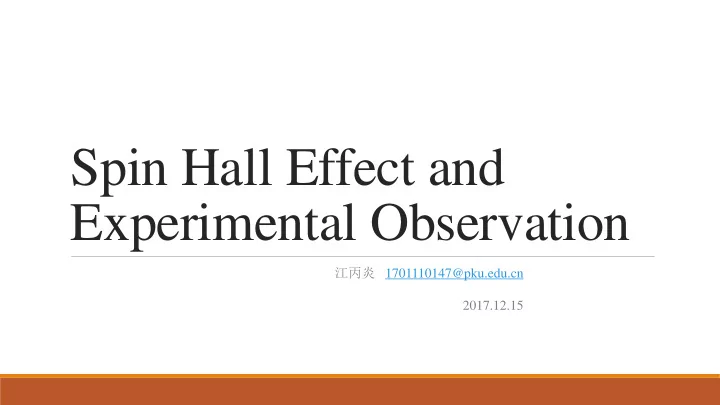

Spin Hall Effect and Experimental Observation 江丙炎 1701110147@pku.edu.cn 2017.12.15
Introduction 1. Hall Effect and Anomalous Hall Effect R B Fig1: Hall Effect
Introduction 1. Hall Effect and Anomalous Hall Effect In ferromagnetic materials or paramagnetic materials in a magnetic field, the Hall resistivity includes an additional contribution: the anomalous Hall effect Depend on the magnetization of the material Often much larger than the ordinary Hall effect Fig2: Anomalous Hall Effect
Introduction 2. Mott scattering: A. An unpolarized beam of electrons is scattered from heavy nuclei in a target. B. Because of the relativistic spin-orbit coupling, large angle ( ∼ 90 ° ) scattering from the first target produces a polarized beam with the spin polarization transverse to the scattering plane. C. Scattering of these polarized electrons from the second target results, again due to the spin-orbit coupling, in a left-right scattering asymmetry that is proportional to the Fig3: Mott double-scattering proposal polarization induced by the first scattering
Introduction 3. Spin Hall Effect and Inverse Spin Hall Effect A. The same number of spin-up and spin-down electrons, thus no transverse charge imbalance B. Mott scattering of electron beams from heavy nuclei in a vacuum chamber can be regarded as the SHE in a non-solid-state environment Fig4: Spin Hall Effect and Inverse Spin Hall Effect
Introduction 3. Spin Hall Effect and Inverse Spin Hall Effect The spin current is determined by the local gradient of the spin dependent chemical potentials which vanishes on the length scale given by the spin lifetime. As long as the connecting wire is longer than the characteristic spin-conserving length scale, there is no difference between a closed and an open spin- current circuit Fig5: SHE and ISHE wired as proposed by Hirsch (1999)
Experiments Science 306 , 1910 (2004) Optical detection of the spin Hall effect in thin films of the semiconductor GaAs and InGaAs. Scanning Kerr rotation measurements show the presence of electron spin accumulation at the edges of the samples, consistent with the prediction of a spin current transverse to the applied electric field. We investigated the effect in both unstrained and strained samples and found that an applied in-plane magnetic field can play a critical role in the appearance of the spin accumulation.
Experiments 𝐶: The Hanle effect: spin precession 𝐵 0 𝐺𝑗𝑢 𝜕 𝑀 𝜐 𝑡 2 +1 𝜕 𝑀 : 𝑓𝑚𝑓𝑑𝑢𝑠𝑝𝑜 𝑀𝑏𝑠𝑛𝑝𝑠 𝑞𝑠𝑓𝑑𝑓𝑡𝑡𝑗𝑝𝑜 𝑔𝑠𝑓𝑟𝑣𝑓𝑜𝑑𝑧 𝜐 𝑡 : 𝑓𝑚𝑓𝑑𝑢𝑠𝑝𝑜 𝑡𝑞𝑗𝑜 𝑚𝑗𝑔𝑓𝑢𝑗𝑛𝑓 𝐵 0 : 𝑢ℎ𝑓 𝑞𝑓𝑏𝑙 𝐿𝑆
Experiments Vol 442|13 July 2006|doi:10.1038/nature04937 𝝂 ↑↓
Experiments 𝑊 𝑇𝐼 are expected to be proportional to P and to decay with spin diffusion length 𝜇 𝑡𝑔 𝜏 × 𝐹 𝜏 ∝ 𝑡𝑗𝑜𝜄, 𝐹 𝜏 = −𝛼𝜈 𝜏 (𝑠) 𝑊 𝑇𝐼 ∝ Ԧ P: The spin polarization of the electrons injected by FM1; depends on the effective tunnel conductance for spin-up and spin-down electrons, respectively 𝐻 ↑ and 𝐻 ↓ , and can be written as : 𝑄 = 𝐻 ↑ −𝐻 ↓ 𝐻 ↑ +𝐻 ↓
Experiments P=0.28 Δ𝑊 is the difference in the output voltage between Obtain P and 𝜇 𝑡𝑔 : parallel and antiparallel magnetization configurations 𝐽 = 𝑄 2 𝜇 𝑡𝑔 Δ𝑆 = Δ𝑊 𝜏 𝑑 𝐵 exp(− 𝑀 𝐺𝑁 ) of the FM electrodes at zero magnetic field 𝜇 𝑡𝑔 𝜏 𝑑 : Charge conductivity; A: Cross-section area.
Experiments Small B: the measurements show the Hanle effect associated with precessing spins. As B increases, the magnetizations tilt out of plane. For large enough B, they orient completely along the field and the measurements saturate to a positive constant value. ± ∝ ±𝑔 𝐶 cos 2 𝜄 + sin 2 𝜄 , thus 𝑊 − ∝ 2 sin 2 𝜄 Calculate 𝜄 : At B=0, 𝑊 + + 𝑊 At 𝐶~1.55𝑈 𝑡𝑗𝑜𝜄 ~1
Experiments 𝜏 × 𝐹 𝜏 ∝ 𝑡𝑗𝑜𝜄 𝑊 𝑇𝐼 ∝ Ԧ 𝑊 𝑇𝐼 ∝ 𝑡𝑗𝑜𝜄 and decay with 𝑀 𝑇𝐼
Summary 1. Brief introduction to Spin Hall Effect and Inverse Spin Hall Effect 2. Optical detection of the spin Hall effect 3. Electronic measurement of the spin Hall effect
Thanks!
Reference [1]. Jairo Sinova, Sergio O. Valenzuela, J. Wunderlich, etal. Spin Hall Effect. REVIEWS OF MODERN PHYSICS, 2015, 87(4): 1213-1247
Recommend
More recommend